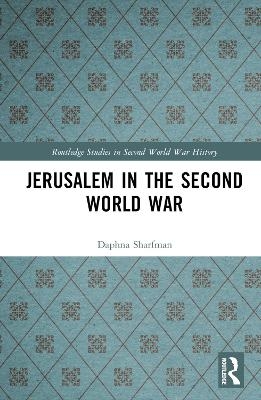
Jerusalem in the Second World War
Routledge (Verlag)
978-1-032-01048-9 (ISBN)
Whilst Jerusalem is usually known for topics such as religion, archaeology, or the politics of the Israeli–Arab conflict, this volume provides an in-depth analysis of this exceptional and temporary situation in Jerusalem, offering a perspective that is different from the usual political-strategic-military analysis. Although battles were raging in the nearby countries of Syria and Lebanon, and the war in Egypt and the Western Desert, the people who came to Jerusalem, as well as those who lived there, had different agendas and perspectives. Some were spies and intelligence officers, other were exiles or refugee immigrants from Europe who managed at the last moment to escape Nazi persecution. Journalists and writers described life in the city at this time. All were probably conscious of the fact that when the war came to an end, local rivalry and mounting conflict would take the centre stage again. This was a time of a special, magical drawn-out moment that may shed light on an alternative, more peaceful, kind of Jerusalem that unfortunately was not to be.
This volume seeks to find an alternative approach and to contribute to the development of insightful research into life in an unordinary city in an unordinary situation. It will be of value to those interested in military history and the history of the Middle East.
Dr. Daphna Sharfman is the author of books and articles in the fields of human rights, human rights and foreign policy, gender studies, and the British mandate in Palestine. Publications include Palestine in the Second World War: Strategic Plans and Political Dilemmas – the Emergence of a New Middle East (2014), Refugees, Human Rights and Realpolitic (2019) and Clandestine Immigration from Italy 1945–1948. (Hebrew) (2020).
Part 1. Introduction and background 1. The Second World War: The strategic situation in Palestine and military operations in the Middle East (1939–1945) 2. Political background: The Jewish-Arab conflict and the British government. Part 2. Living in wartime 3. Civil defence, rationing, and press censorship. 4. Anxious days, 1941 and 1942. 5. The Templers in Palestine in the Second World War: The end of an era. 6. Spies and counterspies. 7. The German ̶ Arab parachuted mission, October 1944 (Operation Atlas). 8. State control of radio and propaganda. Part 3. Living in Jerusalem. 9. Communities and social life. 10. Hotels, cafés, cinemas, and tourism. 11. The New Jerusalem: A history of two neighborhoods. 12. The Arab leadership in the war: Prominent families and politics. Part 4. Writing on Jerusalem 13. Writers and poets: Seeing the city through their eyes. Part 5. History moves on 14. Jerusalem 1945–1948
| Erscheinungsdatum | 03.01.2024 |
|---|---|
| Reihe/Serie | Routledge Studies in Second World War History |
| Zusatzinfo | 1 Line drawings, black and white; 21 Halftones, black and white; 22 Illustrations, black and white |
| Verlagsort | London |
| Sprache | englisch |
| Maße | 156 x 234 mm |
| Gewicht | 620 g |
| Themenwelt | Geschichte ► Allgemeine Geschichte ► Neuzeit (bis 1918) |
| Geschichte ► Allgemeine Geschichte ► 1918 bis 1945 | |
| Geschichte ► Teilgebiete der Geschichte ► Militärgeschichte | |
| Sozialwissenschaften ► Soziologie ► Spezielle Soziologien | |
| ISBN-10 | 1-032-01048-7 / 1032010487 |
| ISBN-13 | 978-1-032-01048-9 / 9781032010489 |
| Zustand | Neuware |
| Haben Sie eine Frage zum Produkt? |
aus dem Bereich


